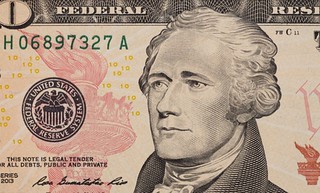
PREV ARTICLE
NEXT ARTICLE
FULL ISSUE
PREV FULL ISSUE
THE 'KEEP HAMILTON' MOVEMENT GAINS STEAM
Last week's surprise announcement that the portrait of Hamilton on the U.S. $10 bill would be removed to make room for a
yet-to-be-chosen woman's portrait generated a lot of interest and controversy. Several commentators have argued in favor of keeping
Hamilton, as did I. Longtime E-Sylum contributor Dick Johnson agrees, and this week no less a figure than former Federal Reserve
Chairman Ben Bernanke backed the cause. Here's one of many articles on the topic. -Editor
The Treasury Department got its debate all right, but not the one it was looking for. Instead of weighing the merits of America’s most iconic women, some of the nation’s most prominent voices have been fighting to save the founding father she would displace: Alexander Hamilton. Chief among them was Ben Bernanke, who as chairman of the Federal Reserve oversaw the central bank responsible for issuing the nation’s currency. “I must admit I was appalled to hear of Treasury Secretary Jack Lew's decision last week to demote Alexander Hamilton from his featured position on the ten dollar bill,” the typically-circumspect ex-chairman wrote on the blog he publishes for the Brookings Institution. In a piece devoted to the exaltation of the country’s first Treasury secretary, Bernanke added that placing a woman on a currency note was “a fine idea, but it shouldn't come at Hamilton's expense.” On the White House’s “We the People” website, two separate petitions have been launched to keep Hamilton on the $10 bill. The controversy stems from the messy convergence of a grassroots movement and a federal bureaucracy moving at its ordinary, glacial pace. For months, a campaign called Women on 20s has been gaining steam in its bid to pressure the Treasury Department into replacing Andrew Jackson on the $20 bill with a woman in time for the 2020 commemoration of the 19th Amendment guaranteeing women the right to vote. This spring, the organization boasted that more than a million people had voted in an online tournament it held to nominate a woman for the $20. (Harriet Tubman was the winner.) And Senator Jeanne Shaheen of New Hampshire introduced legislation to mandate that a woman be placed on the note. Aside from the significance of the number twenty, activists had targeted Jackson because he is easily the most objectionable of the men now featured on the major currency notes. (George Washington, Abraham Lincoln, Ulysses S. Grant, and Hamilton round out the cast. The slave-holding Thomas Jefferson was no saint, but who actually uses $2 bills?) Yet while the Women on 20s push had gained momentum recently, the Treasury Department’s currency redesign process has been years in the making. And the note next slated for a new look was the $10 bill, not the $20. The driving factor behind any change in the currency is always technological rather than aesthetic—the Treasury Department needs to update each note every so often to stay ahead of counterfeiters, and according to the department, security officials in 2013 recommended that the $10 be prioritized “assuming no other counterfeit threats emerge.” In his public remarks, Lew has stressed that the decision was not meant as a snub of Hamilton, a man he hailed for laying “the groundwork for our economy and America’s longterm prosperity.” He promised that Hamilton wouldn’t be kicked off the sawbuck entirely; keeping two distinct designs is one option, or he could be featured in a smaller way or on the back of the note. For the advocates of putting a woman on the $20 bill, Treasury’s announcement has made a jubilant moment considerably more awkward. “This is quite the conundrum,” Barbara Ortiz Howard, the founder of Women on 20s, told me. “This was originally supposed to be a celebration of women and their contributions to this country, and a great byproduct was going to be replacing someone who represents hate. And now we have a bit of a curveball.” To read the complete article, see:
It will be interesting to see how all this sorts out. To me, it sounds like the Treasury is opening the door to commemorative banknote
issues with the option of somehow keeping a Hamilton version around. Politicians could please every portion of the electorate by
regularly calling for new portraits for our currency. I don't think that would actually happen anytime soon, but other countries
issue commemorative banknotes and have people lined up around the block to purchase them at a premium. If the U.S. Mint can suck money
from the pockets of collectors with a plethora of commemorative coins, why not do the same with products of the Bureau of Engraving and
Printing? -Editor
To read the earlier E-Sylum articles, see:

Wayne Homren, Editor The Numismatic Bibliomania Society is a non-profit organization promoting numismatic literature. See our web site at coinbooks.org. To submit items for publication in The E-Sylum, write to the Editor at this address: whomren@gmail.com To subscribe go to: https://my.binhost.com/lists/listinfo/esylum All Rights Reserved. NBS Home Page Contact the NBS webmaster 
|
